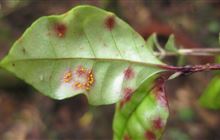Funding helps put myrtle rust under the microscope
Archived content: This media release was accurate on the date of publication.
Introduction
A Jobs for Nature-funded collaboration between communities and scientists is a crucial step in the fight to protect some of New Zealand’s best known native plants, Minister of Conservation Kiri Allan says.Date: 04 October 2021 Source: The Office of the Minister of Conservation
“Myrtle rust poses a threat to some of our most abundant native myrtle species, including the iconic Kiwi Christmas tree, the pōhutukawa, as well as rātā, mānuka and ramarama.
“It is also a threat to our valuable mānuka and kānuka honey industry.
“Two projects, one each in Tairāwhiti/East Coast and the Bay of Plenty, will focus on monitoring myrtle rust infestation, mapping its spread and ramping up the propagation of plants showing the most resistance to the disease.
“Together they represent a $5 million investment in saving at-risk taonga species,” Kiri Allan said.
“It is just over four years since myrtle rust was first detected here yet the effects of it are becoming increasingly apparent. Overseas experience indicates localised extinctions are something we need to be prepared for.
“Myrtle rust leads to a loss of biodiversity. In turn that impacts our wider ecosystem and our cultural identity.”
The two projects announced today are the Te Whakapae Ururoa: Community Myrtle Rust Surveillance Project in Tairawhiti and the Myrtle Rust: Jobs for Resistance project in Rotorua. Together they will be employing 15 people fulltime for the next three years.
“Te Whakapae Ururoa will track spread and infestation at critical sites across a 27,800ha stretch of the East Coast coastline that has been identified as being critically vulnerable to myrtle rust infestation.
“Led by local communities the work utilises grounded knowledge and biocultural monitoring approaches and will be linked into a localised and national reporting system.
“Seed collection, storage and propagation protocols will also be co-developed alongside mana whenua and capability developed to oversee the collection and propagation of native seeds for the East Coast region.
“Jobs for Resistance will identify where the most vulnerable myrtle species are in native forest in the Bay of Plenty region, determine the extent of each population and record the incidence and severity of myrtle rust within them. Cuttings will be taken and seed collections started with the intention of establishing a resistance breeding programme.
“Myrtle rust is a wind-borne disease and is extremely difficult to contain.
“While this work will not prevent infections, it will help us understand how best to support susceptible myrtle species within the indigenous ecosystems.
“Imagine a December without the red blaze of pōhutukawa. None of us want to see these plants become disappear. All of us have a duty of care to do what we can, now,” Kiri Allan said.
Contact
For media enquiries contact:
Email: media@doc.govt.nz


